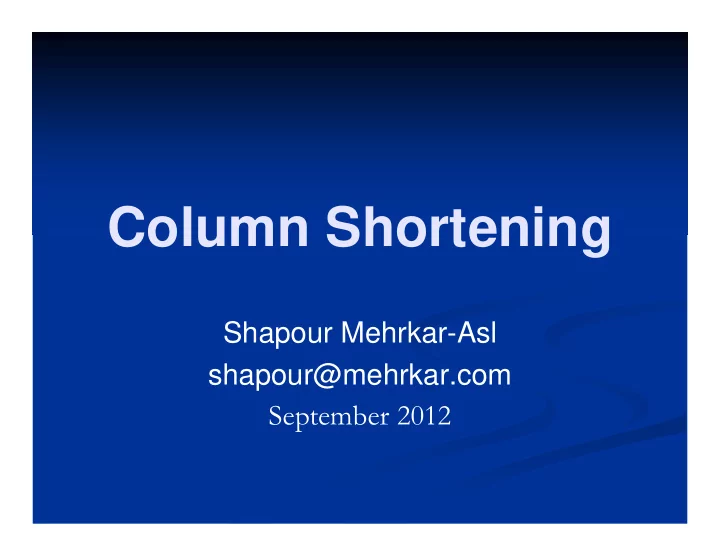

Column Shortening Shapour Mehrkar-Asl shapour@mehrkar.com September 2012
Basic Questions When does it happen? What are the consequences? How to predict it? How to compensate it? Other considerations.
When does it happen? Height of the building Construction sequence Difference in axial stress Difference in cross sectional shapes Reinforcement quantities
What are the consequences? Differential shortening between core & columns. Distortion of slab Redistribution of vertical loads Additional moments in the slab Effects on non-load bearing elements such as Partitions, cladding, finishes & piping
How to predict it? Estimated axial load in vertical elements based on uncracked section properties for all the elements Construction Sequence is assumed Material properties of concrete Elastic Modulus, ultimate shrinkage and specific creep (use experimental values if not then use codified vales) Methods to estimate strength gain of concrete, shrinkage and creep with time Use Mark Fintel et al to calculate shortening Difference between core and columns is shortening of columns
How to compensate it? At design stage try to balance the loads (equal stresses in core and columns) During construction phase: Composite or steel framing For columns with steel cross sections either fabricate them longer or use site steel shims Alternatively put the beam connection points in the core at a lower level For concrete frame columns adjust formwork to the required length
Other Considerations Additional effects Wind loading Temperature effects Differential foundation movements Performance Criteria Material Testing
Elastic Shortening
Ec of High Strength Concrete For normal strength concrete of Ec = 33 w 1.5 √ (f’c) about 57,000 √ (f’c) w in lb/ft 3 = 145 lb/ft 3 f’c in psi (valid to about 6,000 psi) Ec in psi For high strength concrete Ec = 3320 √ (f’c) + 1.0 x 10 6 3,000 < f’c < 12,000 psi
Creep
Specific Creep Low value = 1.5x10 -3 /f’c High value = 2.1x10 -3 /f’c f’c in psi
Shrinkage
Shrinkage
Subsequent Load Creep Elastic Shortening
Rules of thumb for Total Shortening Steel Columns Only Elastic Shortening about 1.5 to 2mm/floor Concrete Columns Elastic Shortening about 0.5 to 0.8mm/ floor Creep about 1 to 2 x Elastic Shortening Shrinkage about 0.2 to 0.5 mm/ floor Overall very similar but happening at different times.
Al Mas Tower 160,000 sq.m 5B+3Podiums+60Floors+3Plants 71 levels 360m in Height Office, retail & diamond exchange
Al Mas Tower
Al Mas Tower
Al Mas Tower
Al Mas Tower
Al Mas Tower
Al Mas Tower Elastic Shortening Long term effects (creep and shrinkage) Principles (effects before and after casting a slab) Self compensating effects Adjustments have to be made Theoretical methods Paper by Mark Fintel, et al. ACI 209 ACI 363 Computer Programs SMA program
Al Mas Tower - Core Core 1 80 70 60 50 E 40 C+S Core Total 30 20 10 0 0 20 40 60 80 100 120 140 160 180
Al Mas Tower - Column Column 3TC3-1 80 70 60 50 E 40 C+S Column Total 30 20 10 0 0 50 100 150 200 250
Al Mas Tower Differential Shortening 80 70 60 50 Core Total 40 Column Total Differential 30 20 10 0 -50 0 50 100 150 200 250
Al Mas Tower Controlling Factors: • Column size/ length • Concrete strength • Conc. properties • Member sizes • Reinforcing amount • Floor dead loads • Superimposed loads • Construction time • Construction loads • Humidity at curing • Temperature
Recommend
More recommend